Abstract
The use of fuel mixtures of diesel and vegetable oils in diesel engines is a field of research due to the necessity of reducing pollution. Besides the properties required for the normal operation of diesel engines, other aspects that must be investigated are linked to the influence of these mixtures on piston ring–cylinder tribosystem behavior. Methods used for reducing the friction and wear on the engine cylinders, such as special surface machining, lubricant driving piston rings, etc., are well known. If the fuel mixture brings some improvement in this area, such as a reduction of the friction coefficient value, this can be a way to reduce the power lost by friction into the engine cylinders. In this paper, a methodology is presented based on artificial neural networks for analyzing the complex relationship between vegetable oil percentages in fuel mixtures, with the goal of finding an optimal proportion of vegetable oil corresponding to a minimum value of the friction coefficient. Regular methods were used for data acquisition, i.e., a pin-on-disk module mounted on a tribometer, and two types of vegetable oils were studied, namely sunflower and rapeseed oils. The obtained results show that for each type of vegetable oil there is an optimal proportion leading to the best tribological behavior.
1. Introduction
The continuously growing number of internal combustion engines has led to a dangerous increase of gaseous emissions into the atmosphere. Consequently, the greenhouse effect has become more and more powerful, leading to many undesired effects, such as global temperature rise, ozone layer degradation, air pollution, etc. The first action towards reducing greenhouse gas emissions was taken in 1997 in Kyoto, when the leaders of 160 countries signed a protocol for the reduction of the emissions of six main gasses [1]. Europe has targeted a unilateral reduction in greenhouse gas emissions of 20% by 2020, and a 30% reduction in the context of a global agreement [2].
Internal combustion engines are an important source of pollutant emissions (around 20%) [2]. Consequently, Romania has taken the decision to increase its consumption of biofuels. These are biofuel mixtures with at least 8% ethanol for gasoline and 6.5% biodiesel for diesel, starting since 1 January 2019 [3].
The most widely used method for obtaining biodiesel is the transesterification reaction [4] of pure vegetable oil, the product of which can be used without engine modifications. Biodiesel can also be obtained from pyrolysis [5], a new method which has two steps, firstly a sulfuric acid hydrolysis and then esterification, showing good results [6].
The main benefits of biodiesel when compared to fossil fuels are its low toxicity, low greenhouse gas emissions, low amount of unburned particles, etc. [5]. Relevant drawbacks are its quick degradation, higher viscosity—leading to the warping of injectors and filters—as well as its high costs and complex technologies [7]. These drawbacks can be reduced by mixing biodiesel with regular diesel.
Another method for reducing car pollution is to directly mix pure vegetable oil with diesel, which reduces the costs of obtaining biodiesel. This concept is not new; biodiesel has been considered as an alternative fuel since 1900 [8], although some authors deny this fact [9]. The vegetable oils that are most widely used as biodiesel are sunflower, rapeseed (mostly in Europe), soybean, corn (mostly in the USA), cotton, and palm. Besides these, there are more than 350 vegetable oils with properties similar to diesel fuel [10].
The optimal percentage of vegetable oil in a diesel mixture has been the subject of several studies. Some of these show that a sunflower oil content of over 5% brings no benefits [11]. However, other authors [12] show that a sunflower oil content of over 5% brings some benefits, such as a reduction in CO and HC emissions, but also some drawbacks, such as higher emissions of NOx and CO2.
A study on rapeseed oil [13] showed that fuel mixtures using this oil produce less hydrocarbon emissions than those based on sunflower oil. The same results were also obtained for corn oil-based biodiesel [14].
Another advantage of fuel mixtures of diesel and vegetable oil is that they have improved lubrication properties, taking into account that around 40–50% of all energy lost through internal engine friction is lost through piston ring–cylinder friction [15]; some authors have even estimated this energy loss at 75% [16]. Consequently, several studies on the influence of biodiesel–diesel mixtures on piston ring–cylinder friction have been performed. It was found [17] that a mixture with 20% of transesterified vegetable oil and 80% of diesel leads to lower wear on the cylinder. From this point of view, the tribological properties of some vegetable oils become important for obtaining fuel mixtures with improved lubricant properties, since pure oils such as sunflower, rapeseed, and soybean have been proven to have good lubricant properties [18,19].
This paper presents a study of the tribological behaviors of mixtures of rapeseed and sunflower oils with regular diesel. As the future of automotive fuels belongs to low-pollution mixtures, the tribological behaviors of such mixtures must be further investigated. Three vegetable oil–diesel mixtures were used, namely 5%, 10%, and 20% vegetable oil, as these percentages comply with the literature [11]. Higher vegetable oil concentrations are not desirable, since the CO2 emissions in these cases are noticeably higher [20,21].
2. Materials and Methods
This paper proposes a method to establish the optimal content of rapeseed or sunflower oil in a regular diesel-based mixture for use as an automotive fuel, based on artificial neural network (ANN) analysis. As other authors have proved [17], there is an optimal ratio of vegetable oil and diesel fuel which leads to reduced wear on the piston rings–cylinder system.
Taking into account that a relationship between fuel mixture composition and friction coefficient evolution is difficult to establish, a machine learning based method is approached. As one can view in Figure 1, there are several machine learning techniques. Since in this study pairs of input-output data are available, a supervised learning technique should be used. As the final goal is to predict the friction coefficient value when the vegetable oil content in fuel is known, a regression technique is appropriate. Looking to regressions methods, an optimal one should be chosen for the present paper goal. Both linear and non-linear regressions (Linear Regression and SVR–GPR) assumes to fit the experimental data with a mathematical equation, which is not suitable for this study, since there is no mathematical relationship there. The Ensemble Methods and Decision Trees (Regression Trees subtype) are also unsuitable for this work, even they rely on "white box" models, since their learning algorithms are based on heuristics (Greedy Algorithm for example) where locally optimal decisions are made at each node.
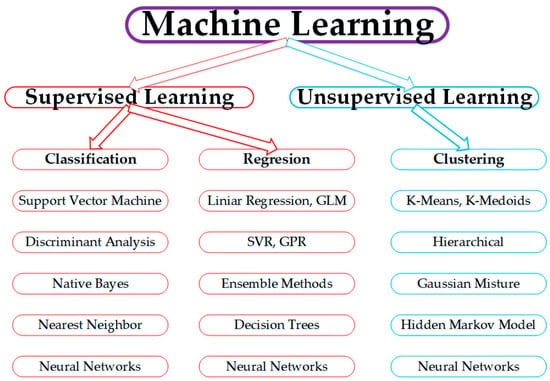
Figure 1.
Machine learning techniques [22].
The Neural Networks, on the other hand, can be successfully used for the purpose of present paper. These machine learning algorithms, especially those with several hidden layers (known as deep-learning neural networks) rely on so called "black box" model and not on a mathematical equation or on a heuristic procedure [23]
2.1. Artificial Neural Networks
ANNs are calculation tools that are well known for their ability to model the relationship between datasets with no mathematically based link. As a replica of biological brains, ANNs are composed of interconnected neurons placed into a layered structure [24]. Each neuron receives information from the others, processes it with a specified transfer function, and passes it forward to the exit. There are several types of ANN architecture, which differ in terms of information flow, and each of which is appropriate for different kind of analyses. Taking into account the present problem—finding a determining link between the oil concentration in biodiesel fuel and the tribological behavior of the piston rings–cylinder system—the appropriate ANN is the feedforward ANN [25], as shown in Figure 2. In a feedforward ANN, the information flows only from input to output and there are no loops, as in, for example, a feedback ANN. Consequently, these ANNs are suitable for functional mapping problems, i.e., finding how a number of input variables affect the output variables. Such ANNs require a dataset composed of known input–output pairs, which are used for the ANN training stage. During the training, the dataset is used for weighting the inter-neuron links, performing several cycles, in such way that, in the end, for a certain input into the ANN, the corresponding output must be obtained, with a prescribed training error.
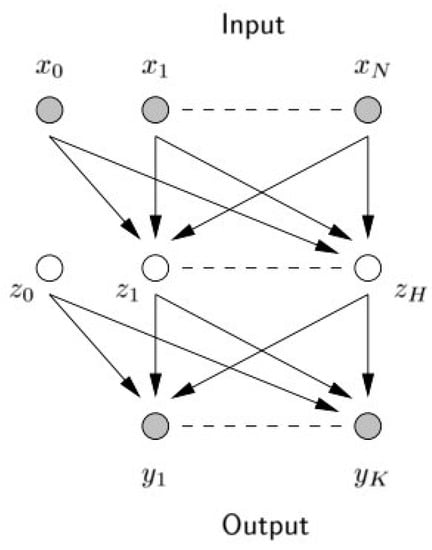
Figure 2.
Feed forward artificial neural network architecture, where: x—input nodes, z—hidden nodes, y—output nodes.
Several methods are available for training error control algorithm, however the back-propagation method is the most suitable as it has a low memory requirement, reaches an acceptable error level quickly, and can be used on most types of networks [26].
Given known input dataset values, trained ANNs can be used for prediction—the ANN delivers predicted output data—or for optimization—the ANN gives the input dataset values for a desired output, generally maximum or minimum values.
In order to use an ANN, dedicated software must be used. This software allows the user to build an ANN, choose the appropriate architecture for the analyzed problem, train the ANN, and use it. In this study, for ANN building, training, and querying, the Neural Power software (NeuralWare, Carnegie, PA, USA) was used. This choice was made based on some benefits of this software, namely the possibility to choose a different transfer function for each layer, the possibility to use different training and optimization algorithms, and the possibility to directly represent both input and output data graphically. In order to obtain the necessary data, tribological tests must be performed.
2.2. Materials and Data Acquisition
In order to analyze the influence of the oil added to diesel fuel on tribological behavior, commercial-grade rapeseed and sunflower oils were chosen. Three mixtures, with 5%, 10%, and 20% oil, were used. The density and viscosity of the diesel, oils, and diesel–oil mixtures are presented in Table 1. The obtained mixtures were tested on a UMT-2 CETR tribometer (Bruker Nano Inc., Campbell, CA, USA) in a pin-on-disk module, as shown in Figure 3.

Table 1.
Properties of materials; where: S—sunflower oils, R—rapeseed oil.
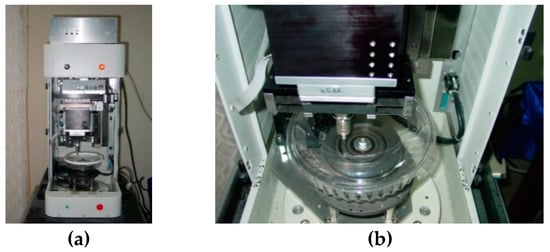
Figure 3.
Tribotest setup: (a) UMT-2 tribometer; (b) pin-on-disk module.
After the preliminary tests, in order to establish the time period for the stabilization of the friction coefficient value (FCV), the vegetable oil–diesel mixtures, which were obtained by mechanical mixing, were tested in a steel/cast-iron couple for 1200 m sliding, with the same values of loading force (100 N) and speed (40 m/min). Since the goal of the investigation was to establish the influence of the vegetable oil content of the mixtures on the friction coefficient, some factors related to the piston ring–cylinder couple, such as temperature, speed variations, surface roughness, etc., were ignored [17]. Rather, the present study only investigated the friction coefficient values for the studied fuel mixtures.
After preliminary tests, for each mixture (i.e., 5%, 10%, and 20% of rapeseed oil and 5%, 10%, and 20% of sunflower oil), five tests were performed, and the average friction coefficient value was recorded. In order to obtain a comparison base, tests were also performed on pure diesel fuel and the friction coefficient values were also recorded.
2.3. Analysis Methodology
The experimentally acquired dataset was used for building and training an ANN, with the goal of investigating the influence of oil percentage on the friction coefficient value and optimizing the vegetable oil–regular diesel mixture proportions.
In ANN-based modeling, the choice of network architecture and accepted training error value have a great influence on both the training time and the prediction error. Setting the training error value too low forces the ANN to become over-fitted and reduces its capacity to process other datasets than the training ones, which consequently gives rise to high prediction errors. In order to avoid this behavior, the training error must be carefully chosen, assuming a higher prediction error value and a higher processing capacity of the ANN. For the present study, several preliminary tests were performed, with different ANN architectures and training error values, in order to establish the best combination to give the lowest number of training cycles and lowest validation error. Consequently, a feedforward ANN network with the architecture presented in Figure 4 was used. As a stopping criterion for the training stage, an RMSE <0.001 was used, as shown in Table 2.
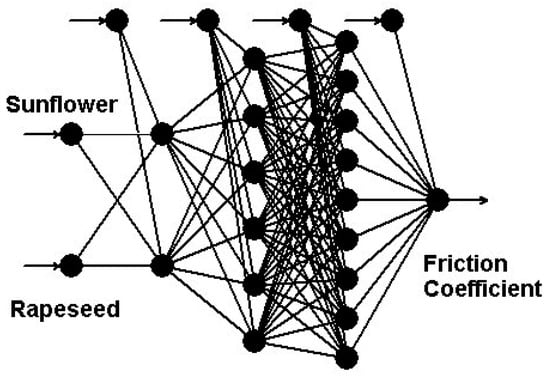
Figure 4.
ANN architecture

Table 2.
Stopping learning criteria.
The ANN was trained with a back-propagation algorithm, and all neuron transfer functions were the tangential one given in Equation (1). Compared to the widely used sigmoid function (Equation (2)), the tangential function offers stronger gradients and a larger input value interval (x∈ [−1, 1] for the tangential function and x∈[0, 1] for the sigmoid function).
The data used for ANN training were the results obtained from the aforementioned experimental tests. After the training stage, a validation procedure must be performed in order to evaluate the ANN’s capacity to describe the studied phenomenon. During this stage, some input data are presented to the ANN, and the delivered outputs are compared with the real ones. Table 3 presents the obtained prediction results for friction coefficient values (FCV). For the average deviation formula, Equation (3) was used, and for Relative deviation formula, Equation (4) was used.

Table 3.
ANN validation results.
3. Results
Given some experimental measurements and an ANN that is trained for the modeling of friction coefficient evolution, several investigations can be performed to predict friction coefficient values for different oil–diesel mixtures or to establish the optimal vegetable oil content of such mixtures.
3.1. Influence of Vegetable Oil Content on Friction Coefficient Value
Figure 5 presents the variation in friction coefficient values for different percentage mixtures of rapeseed and sunflower oils with diesel fuel. As can be seen, the addition of vegetable oil leads to a significant decrease in the friction coefficient value.
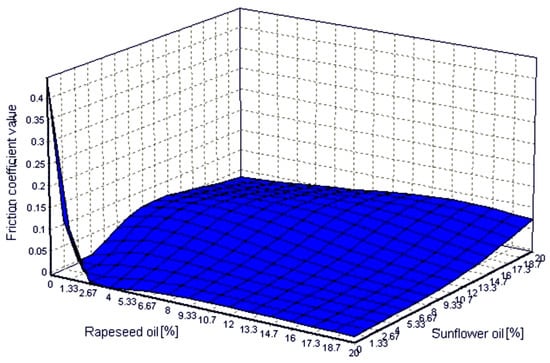
Figure 5.
Variation in the evolution of friction coefficient values for different concentrations of the two vegetable oils.
The influence of rapeseed oil and sunflower oil on friction coefficient when only one oil is used are presented in Figure 6. It was observed that a minimum concentration of 4% must be used in order to comply with environmental protection requirements. The differential influence of the studied oils is obvious: rapeseed oil leads to the lowest friction coefficient values at high concentration (Figure 6a), while sunflower oil leads to the lowest friction coefficient values at low concentration (Figure 6b).
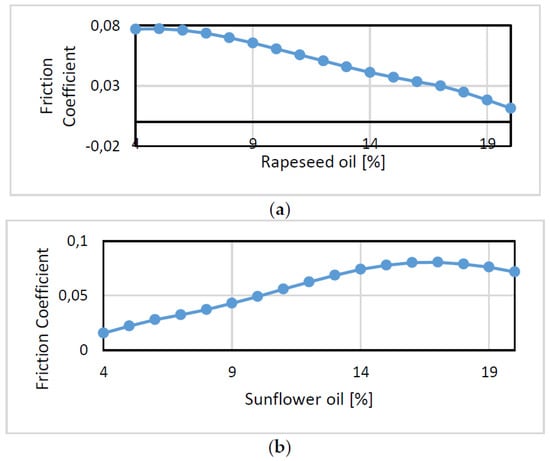
Figure 6.
Effect of vegetable oil concentration on friction coefficient values: (a) rapeseed oil; (b) sunflower oil.
By using the trained ANN, an analysis can be performed in order to establish the input with the most influence on output, i.e., which oil has more influence on friction coefficient variation. From this point of view, the oil with the most influence is sunflower oil, as shown in Figure 7.

Figure 7.
Importance of vegetable oils on influencing the friction coefficient value.
3.2. Tribological Optimization of Vegetable Oil Content
The ANN allows the optimal concentration of vegetable oil in a diesel fuel mixture to be established. From the point of view of this study, a minimal value of friction coefficient is desired. By applying a force approach algorithm to the ANN-predicted data, the results presented in Table 4 were obtained.

Table 4.
Optimization results.
As can be seen in Table 4, the optimal recipe a vegetable oil-diesel fuel mixture, from tribology point of view is with 4% sunflower oil and no rapeseed oil. This way, a contribution to environment protection can be obtained, both by reducing toxic emission and by reducing the power lost by friction.
4. Discussion
This study of the tribological properties of mixtures of sunflower and rapeseed oils with fossil diesel showed that the presence of vegetable oil leads to a significant reduction of friction coefficient values compared with pure fossil diesel fuel (see Figure 4). Different behaviors were observed for the two vegetable oils: for rapeseed oil, the lowest friction coefficient values were obtained for high concentrations, while for sunflower oil, low concentrations led to the lowest friction coefficients (see Figure 5).
The optimization procedure performed using the trained ANN obtained the lowest friction coefficient value for 4% sunflower oil and no rapeseed oil (see Table 4). This result is in concordance with the results presented in [11], as well as with the ANN result regarding the influence of inputs on output shown in Figure 6. From a tribological point of view, the percentage of rapeseed oil has a lower influence on the friction coefficient compared to sunflower oil, even though it leads to a decrease in the friction coefficient value.
From a tribological point of view, the use of a mixture containing both sunflower and rapeseed oils is not justified. Moreover, it was observed that at high concentrations, rapeseed oil leads to higher friction coefficient values (see Table 4).
Using the prediction ability offered by the trained ANN, the inclusion of 6.5% of sunflower oil in fossil diesel—as recommended by [2]—can be tested for its influence on the friction coefficient value. Table 5 presents the results obtained for 6.5% vs. 0% sunflower oil content.

Table 5.
Prediction results.
As can be seen in Table 5, the friction coefficient value for 6.5% of sunflower oil in biodiesel is higher (more than double) than that shown in Table 4. However, since this value is more than 10 times lower than that obtained for pure fossil diesel, it can be concluded that this oil mixture is appropriate from a tribological point of view.
5. Conclusions
The following final conclusions can be made:
- The use of vegetable oil–fossil diesel mixtures as fuel for internal combustion engines is more and more appropriate.
- Besides their benefits regarding greenhouse gas emissions, the tribological implications of such mixtures must be studied.
- Using an ANN trained with data experimentally obtained using tribometer devices, an accurate analysis can be performed on the behavior of biodiesel–diesel mixtures from a tribological point of view.
- Based on ANN analysis, the optimal percentage of sunflower oil in a biofuel mixture was identified, and was found to be in perfect correlation with the findings of other authors.
Author Contributions
C.H. and V.A. did the literature review. C.H. analyzed the results, discussed the data, and drawn the main conclusions. V.A. did the data acquisition. S.C. build, trained and analyzed the data from ANN (2.1 and 2.3). All of the authors have participated in the writing of the paper. The final manuscript has been approved by all the authors.
Funding
This research received no external funding.
Conflicts of Interest
The authors declare no conflict of interest.
References
- Kyoto Protocol—Targets for the First Commitment Period | UNFCCC. Available online: https://unfccc.int/process/the-kyoto-protocol (accessed on 3 February 2019).
- Official Journal of the European Union. Available online: https://eur-lex.europa.eu/legal-content/EN/TXT/HTML/?uri=CELEX:32009L0030&from=EN (accessed on 14 November 2018).
- Guvernul României Ordonanță de Urgență. Available online: https://sgg.gov.ro/new/wp-content/uploads/2018/09/OUG-1.pdf (accessed on 3 November 2018).
- Meher, L.C.; Vidya Sagar, D.; Naik, S.N. Technical aspects of biodiesel production by transesterification—A review. Renew. Sustain. Energy Rev. 2006, 10, 248–268. [Google Scholar] [CrossRef]
- Nigatu Gebremariam, S.; Mario Marchetti, J. Biodiesel production technologies: Review. AIMS Energy 2017, 5, 425–457. [Google Scholar] [CrossRef]
- Ma, G.; Dai, L.; Liu, D.; Du, W. A Robust Two-Step Process for the Efficient Conversion of Acidic Soybean Oil for Biodiesel Production. Catalysts 2018, 8, 527. [Google Scholar] [CrossRef]
- Chiu, C.-W.; Schumacher, L.G.; Suppes, G.J. Impact of cold flow improvers on soybean biodiesel blend. Biomass Bioenergy 2004, 27, 485–491. [Google Scholar] [CrossRef]
- HISTORY OF BIODIESEL. Available online: http://www.arizonaenergy.org/docs/HISTORY%20OF%20BIODIESEL.html (accessed on 4 November 2018).
- Scientific Milestones—AOCS Lipid Library. Available online: http://lipidlibrary.aocs.org/History/content.cfm?ItemNumber=39263 (accessed on 14 January 2019).
- Chincholkar, S.; Srivastava, S.; Sidiqui, A.; Dixit, S.; Lanjewar, A. Biodiesel as an Alternative Fuel for Pollution Control in Diesel Engine. Asian J. Exp. Sci. 2005, 19. [Google Scholar]
- Beck, Á.; Hancsók, J.; Krár, M. Application of sunflower oils with high oleic acid content and their derivates as fuels for Diesel engines. Chem. Eng. Trans. 2007, 11, 893–898. [Google Scholar]
- Imran, M.S.; Kurji, H.J.; Mohammed radhi, R. The impact of using biodiesel prepared from waste sunflower oil & iraqi conventional diesel on compression ignition engine performance and emissions. J. Mech. Eng. Res. Dev. 2018, 41, 32–37. [Google Scholar]
- Maria, F. Hydrocarbon emissions from biofuel based on rapeseed oil compared to diesel fuel in diesel engine D-2402. Res. J. Agric. Sci. 2011, 43, 289–296. [Google Scholar]
- Imran, M.S.; Kurji, H.J. The Effect of Using Waste Corn Oil on Compression Ignition Engine Performance. Int. J. Appl. Eng. Res. 2018, 13, 9. [Google Scholar]
- Söderfjäll, M. Friction in Piston Ring—Cylinder Liner Contacts. Ph.D. Thesis, Luleå University of Technology, Luleå, Sweden, 2017; p. 226. [Google Scholar]
- Nocera, E.; Bruno, R.A.; Silva, D.; Bieneman, J. High Durability and Low Fuel Consumption Ring Pack for HDD Engines; SAE International: Warrendale, PA, USA, 2013. [Google Scholar]
- Balakumar, R.; Sriram, G.; Arumugam, S. Effect of Lubricant contaminated with Waste Ayurvedic Oil Biodiesel on Tribological Behavior of Cylinder Liner-Piston Ring Tribo pair Material. Mater. Today Proc. 2018, 5, 13220–13226. [Google Scholar] [CrossRef]
- Radulescu, I.; Radulescu, A.V.; Georgescu, C.; Deleanu, L. Rapeseed oil versus soybean oil—Rheological and tribological properties. In Proceedings of the International Scientific Conference “BALTTRIB 2017”, Akademija, Lithuania, 16–17 November 2017. [Google Scholar]
- Şolea, L.C.; Deleanu, L.; Georgescu, C. Evaluation of Olive Oil as Lubricant with the Help of Four-Ball Tester. Mech. Test. Diagn. 2013, 3, 40–48. [Google Scholar]
- San José Alonso, J.; López Sastre, J.A.; Romero-Ávila, C.; López Romero, E.J. Combustion of rapeseed oil and diesel oil mixtures for use in the production of heat energy. Fuel Process. Technol. 2006, 87, 97–102. [Google Scholar] [CrossRef]
- López Sastre, J.A.; San José Alonso, J.; Romero-Ávila García, C.; López Romero-Ávila, E.J.; Rodríguez Alonso, C. A study of the decrease in fossil CO2 emissions of energy generation by using vegetable oils as combustible. Build. Environ. 2003, 38, 129–133. [Google Scholar] [CrossRef]
- What Is Machine Learning? How It Works, Techniques & Applications. Available online: https://ch.mathworks.com/discovery/machine-learning.html (accessed on 3 February 2019).
- Artificial Intelligence (AI) vs. Machine Learning vs. Deep Learning. Available online: http://skymind.ai/wiki/ai-vs-machine-learning-vs-deep-learning (accessed on 3 February 2019).
- Hristev, R.M. The ANN—Book. Available online: http://www.pdg.cnb.uam.es/cursos/Complutense/Complutense2004/pages/12_NeuralNetworks/Hritsev_The_ANN_Book.pdf (accessed on 3 February 2019).
- Hui, C.L.P. Artificial Neural Networks—Application; IntechOpen: London, UK, 2011; ISBN 978-953-307-188-6. [Google Scholar]
- Hagan, M.T.; Demuth, H.B.; Beale, M.H.; De Jesus, O. Neural Network Design, 2nd ed.; Amazon Fulfillment Poland Sp. z o.o: Wrocław, Poland, 1996; ISBN 978-0-9717321-1-7. [Google Scholar]
© 2019 by the authors. Licensee MDPI, Basel, Switzerland. This article is an open access article distributed under the terms and conditions of the Creative Commons Attribution (CC BY) license (http://creativecommons.org/licenses/by/4.0/).